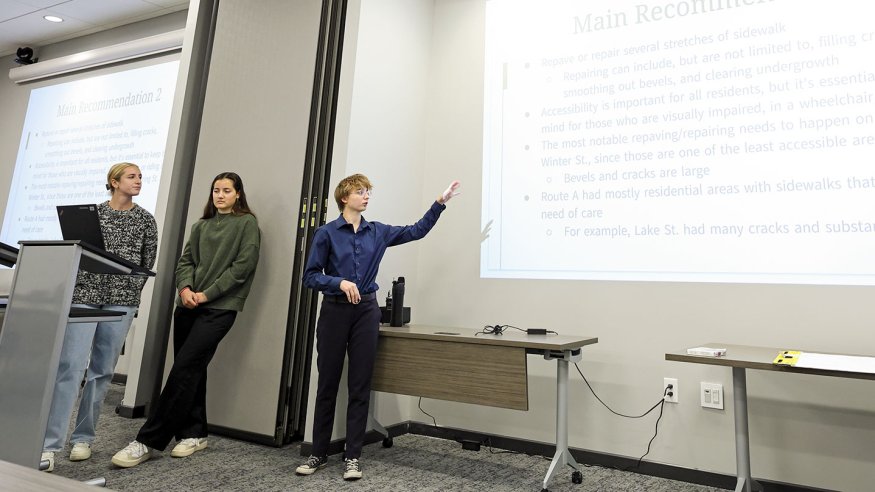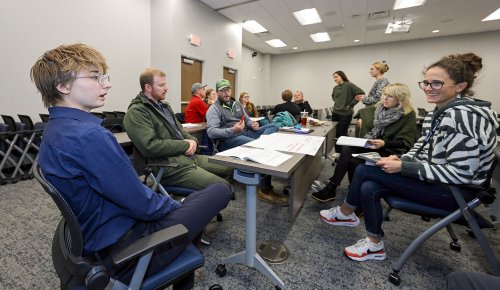
Walking the Walk
OWU Public Health Students Work to Make Delaware More Pedestrian-Friendly
Ohio Wesleyan University's new Public Health Program is stepping off on a positive note in its effort to create a safer, stronger, and healthier community.
Twenty-five students in professor Christopher Fink's Introduction to Public Health class spent two weeks this fall completing a walk audit – exploring four pedestrian routes throughout the City of Delaware, analyzing their findings, and developing recommendations to improve the city's walkability.
"We want authentic work for students to do to benefit the community," said Fink, Ph.D., professor of Health and Human Kinetics and co-director of the Public Health Program, which launched this fall. "We're excited about this collaboration, and it's just the beginning of the important work our students will be able to do as part of the Public Health major."
On a recent afternoon, three of Fink's students – sophomores Quinn Dachisen of Stanhope, New Jersey; Aaron Gonzales of Richfield, Ohio; and Alyssa Markell of Leesburg, Virginia – presented the findings of their class's audit to an audience of Delaware Public Health District, City of Delaware, and SourcePoint workers.
'Safety, Accessibility, and Sidewalks'
"As Ohio Wesleyan students, we rely majorly on walkability," said Gonzales, who is studying Public Health and Sociology/Anthropology. Gonzales noted the class grouped its findings into "three main important concerns tied to safety, accessibility, and sidewalks."
Markell, who is studying Public Health and Nutrition, said that during their two days of walking for the audit, "a lot of students felt unsafe" while trying to navigate city traffic.
And Dachisen, who is studying Public Health and Exercise Science, added, "Regarding accessibility, there were concerns on every route."
To make their recommendations as relevant as possible, the Ohio Wesleyan students created a changeability matrix to document their suggestions in one of four quadrants: high effort-high impact, high effort-low impact, low effort-high impact, and low effort-low impact.
Next, they boiled down their work to create three main recommendations:
- Add marked crosswalks and pedestrian-activated crosswalk signals at the intersection of Lake Street and East Central Avenue.
- Repave or repair sidewalks to fill cracks, level uneven pavement, and clear undergrowth, making the venues safer for everyone, especially those who are visually impaired, using wheelchairs, or riding bicycles. Sidewalks recommended for improvements include areas of Lake, Spring, and Winter streets.
- Improve the safety of East Central Avenue and U.S. Route 23 ramp area. Possible solutions include adding a stop light, pedestrian island, or median strip.
Creating Forward Momentum

After they completed their presentation, the OWU students invited the audience to think about the class's recommendations, add their own, and create new changeability matrices. The audience also discussed possible future actions and audits.
The OWU Introduction to Public Health class collaborated on the walk audit with Josie Bonnette, community health specialist for the Delaware Public Health District, where the presentation was held, and Jackie Haight, age-friendly coordinator for SourcePoint, which supports Delaware County residents age 55 and older.
"This project ties into the Community Health Improvement Plan," Bonnette said. "One component of the plan is to promote physical activity. We want to make it easier for people to walk, and this is a great way to support that goal."
Learn more about Ohio Wesleyan's Public Health Program and the opportunities open to its majors at owu.edu/PublicHealth.
